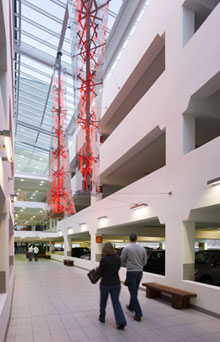Public Art Commissioning and the Credit Crunch
A brief research paper examining how the current credit crisis is affecting public art commissioning in the UK
Britain has officially entered a recession for the first time since 1991, after the economy shrank at increasing speed over the last two quarters of 2008 – the fastest rate of decline for almost 30 years.
The economic downturn has meant the housing market has virtually stopped, car production has plummeted and unemployment has risen sharply to almost 2 million. The manufacturing, service, financial and business sectors have all shrunk and job losses are announced every day. Even the government sector has fallen by 0.5%.
How is all this negative activity affecting public art commissioning, and the people who are involved in it?
On a broad scale, public art commissioning linked to commercial and residential development will obviously be affected, as developments slow down or stop, and new developments fail to come on line. We may well have seen the last of the likes of the Bristol Broadmead public art programme – a commercial development so large that the commissioning programme budget alone is reputed to have totalled £2 million.


Neon work in new car park by Vong Phaophanit and Claire Oboussier at Broadmead, Bristol.
Photo:
Paul Grundy & Murray Scott
Reductions in commercial development can also lead to reductions in publicly-funded new development, as local authorities’ capital income decreases from reduced land sales and reductions in planning application fees.
The combination of developers who are desperate to save money, and local authorities who desire new developments in order to create jobs, may create further pressure on planning policy. This could potentially lead to Planning Conditions becoming more relaxed, particularly where policy has not been officially adopted. So where developments actually do happen, it might be that something like public art commissioning is no longer included in the list of developer requirements. As a knock on effect, work with local authorities to develop their public art policies and strategies could also slow down, when there seems to be little chance of such policies having any opportunities for implementation in the near future.
Talking to people across the field in recent weeks however, things are not relentlessly gloomy, and a mixed picture emerges of what is actually happening on the ground:
Planning and Local Authorities
Planning applications to local authorities have decreased sharply over the last year. The latest national figures available show that in the third quarter of 2008 (up to September), planning applications fell by 19% compared to the same quarter in 2007 (UK Statistics Authority, December 2007). This varies widely, with one council I spoke to estimating that applications were now down by 40%. Is this affecting how authorities with public art policies are treating new applications?
For those with long established policies and public art officers in place, it seems not. At Gateshead, public art curator Anna Pepperall reports that whilst large scale commercial development is clearly down, public sector work carries on, with the policy of involving artists being enforced as usual by the planning department. For example, in recent weeks she has attended early discussion meetings about projects such as health centres and police stations.
At the other end of the country, Southampton has seen a number of major developments, which included public art, slowing down or re-phasing their projects – so whilst schemes are not being cancelled they will take appreciably longer to come to fruition. The planning department line is clear, however, that they are going to be implementing their planning policies across the board, and have no intention of jeopardising ten years of progress in the quality of the public realm.
Birmingham City Council continues its policy of involving artists, and continues to be busy with large scale public projects – a new library, education, transport, parks and health schemes. On the positive side, Nigel Edmondson of their City Design Team feels the downturn in activity is resulting in their team becoming more focused on ensuring high levels of design quality, and potentially a lower caseload may give planners more opportunity to pick up on enforcement.
However, it does seem likely that in many cases, developers who already have permission are trying to renege on their commitments – recent research by consultancy EC Harris suggests that developers are re-negotiating up to 50% of previously agreed deals. And of course there are a huge number of projects which, if they have not stopped completely, have slowed down dramatically, and so the requirement to actually fulfil Planning Conditions won’t kick in for some time. The Harris research estimates that £75billion of regeneration projects with section 106 contributions (legal agreements where the developer provides community benefits, including public art, as part of a planning permission) have stalled.
What is the experience in the design professions? Architecture is being severely hit by the recession, with redundancies and office closures. The story is generally the same however – if a project is in progress, it might slow down but should eventually get built, and projects for public clients seem to be continuing. But as for testing the water on whether new developments will still include artist commissioning, the development market is completely flat, with even the biggest architectural firms seeing little or no new work. I spoke to a partner in an international architectural firm who felt that their clients would still retain their integrity in terms of quality of design and artist involvement – but only once the market picks up.
Landscape architecture tells a similar story – Ros Southern, of Southern Green Ltd describes her practice as being busy with public sector work, but housing projects, for example, stopped abruptly about six months ago. From her point of view, this means a decrease in smaller scale artists/craftspersons commissions which were a feature of many residential schemes.
What of the developers themselves? Michelle Percy, of Silverlink Properties in the North East, a developer with a strong track record of working with artists, feels that recession is the time to be investing more in quality, to make it worthwhile for tenants to stay in their properties, and to be as competitive as possible in a difficult market. And in their view, working with artists adds a high degree of quality to the environment of their developments. They are currently working on a large development site in Newcastle city centre which has an ambitious arts strategy, including temporary work on site during the development process. A work by Sans façon is currently on site and a series of curator led spaces is planned as an ongoing programme of artist commissions, once the development is complete.
![]()
“Iconic Site” by Sans façon, temporary neon work at Stephenson Works, Newcastle upon Tyne. Photo: Silverlink
Nathan Cornish of Urban Splash echoes the view that his company would not decrease its quality of design and development, or dilute the strong brand that they are known for. However, as with everyone else, their activity has slowed down - developers are being hit twice by the banking crisis - banks won’t lend to developers to build, and equally won’t lend to the occupiers to buy. He is concerned that some developers may well use the recession as an excuse to reduce the quality of schemes, and hard-hit councils will accept them in this climate.
Commissioning Agents and Agencies
There is general agreement among the commissioning profession that work is hard to find and opportunities have decreased dramatically, but the public sector carries on, for the time being at least. Aside from the immediate economic worries about the downturn, some issues of quality are also stirring. Charity Green at Commissions East points out that the economic climate can threaten best practice, for example with people taking fewer risks in working with artists - leaving commissions till the last minute and reducing their scale.
Conversely, some in the field see the downturn as an opportunity to increase quality, suggesting there has been too much work commissioned too quickly in the past. Richard Hollinshead at Grit and Pearl, a consultancy working across the north of England, thinks that the proliferation of project work in the past has lead to some careless work, and it might be better if the sector was more “lean”.
Equally, others see the downturn as an opportunity to look at more meaningful ways of working – concentrating more on the role that artists can play in engaging with people and communities, with smaller scale outcomes rather than the “trophy” collections of large scale, dramatic works.
Artists are seeing a decrease in new public art opportunities, as well as cancelled or stalled projects. Those who relied heavily on public art commissioning for their income are having to diversify. Again, some see this as not necessarily a bad thing – allowing more time to properly develop other projects, and in some cases, allowing the artist to spend time making new work which is not destined to fulfil someone else’s brief.
After three years of incredibly busy back to back public commissions, artist Katayoun Dowlatshahi has finally seen a slow down, and is now spending more time teaching, developing her own work for an exhibition, and working as a Trustee for a local arts organisation.

Proposal by Katayan Dowlatshahi, detail of screen printed photographic images on glass wall of new restaurant - Tannery Housing development, Canterbury (development currently on hold). Image: Katayan Dowlatshahi
Artists Heinrich and Palmer are well known for their work in the public realm, but their practice has always been diverse, allowing enough flexibility to keep a good flow of work coming in during changing trends. Whilst public art projects still make up a large part of their work, they have recently been working on creative projects in schools, which can result in a number of different outcomes, not only permanent artworks or installations.

“Illuminate” by Heinrich and Palmer at Bay House School, Gosport. Photo: Claire Coates, Bay House School
ACE officers say it’s too early to consider any policy changes as a result of the downturn, although they are in the process of developing a new architecture policy. However, the current massive ACE reorganisation means that ACE is going to be in flux for some time.
The public art think tank ixia makes reference to the economic downturn on their website and the recent report from Liverpool John Moores University about the impact of the credit crunch on the recession. ixia “believes that major public sector regeneration agencies will potentially become key drivers for the public art sector as the Government encourages them to stimulate the economy by releasing the funding and land they hold … However, the public art sector will only be able to seize these opportunities if appropriate policies and plans are in place, and the skills and capacity are available to see they are implemented….”
Conclusion - What of the Future?
Gordon Brown has announced his intention to spend out of the recession, putting money into public projects to provide jobs and forward momentum. But it is questionable how much public art commissioning might come out of the road and rail expansion schemes he seems to be talking about.
Certainly at the moment, the public sector is providing much of the new and continuing artist commissioning work. And CABE is keen to ensure that the recession does not affect design quality – “Investment in public building in a recession creates jobs and minimises hardship, but that investment must create high quality, low carbon buildings and places in order to generate value for decades to come” .
However, there will undoubtedly be much less work around for artists, commissioning agents and agencies, and it seems inevitable that businesses are going to go under - jobs are already beginning to go in the commissioning agencies. We also need to be cautious in assuming that the public sector will continue to provide an ever-flowing stream of new development work. Local authorities are in difficult times – Leeds City Council has recently announced 450 redundancies – and both the money for new developments and the motivated staff who wish to include artists’ work, are going to become thin on the ground.
So it seems that opportunities will continue to arise, but only if good design and quality of public realm policy remains solid. We need to hope that our policy makers can continue to lobby the public sector and regeneration agencies to ensure this, and practitioners in the field need to continue to show the value and relevance of involving artists in our public realm.
© Hazel Colquhoun 2009
